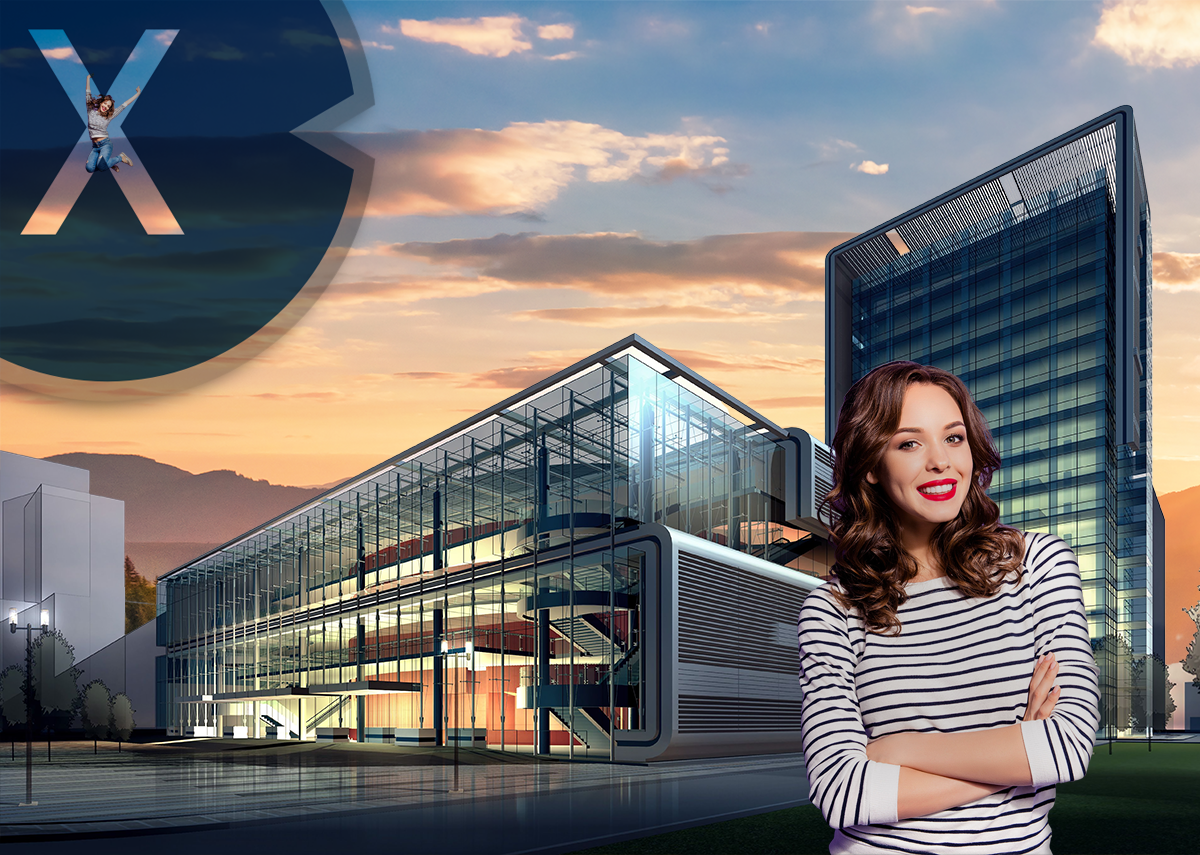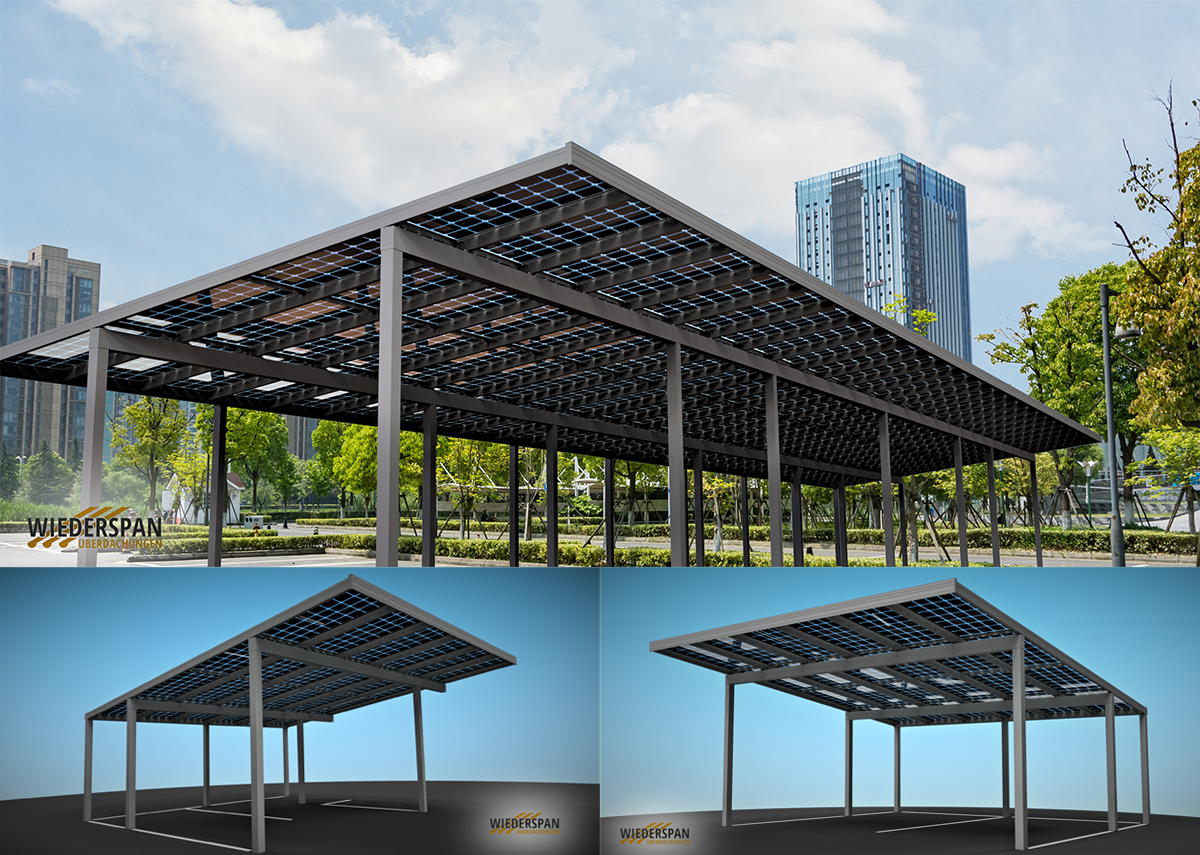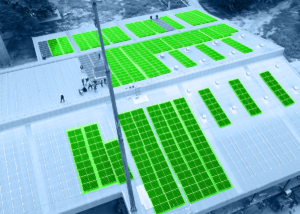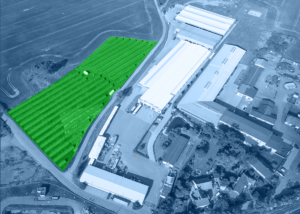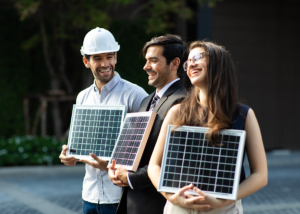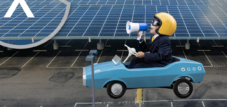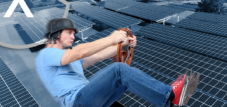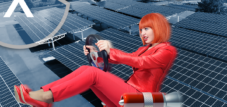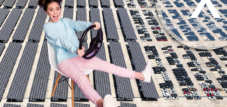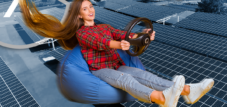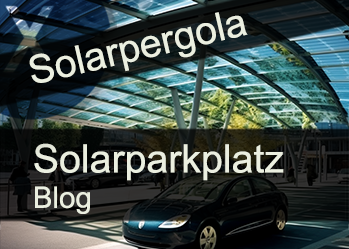Solar pavilion in the city: Innovative photovoltaics roofing for cities with partial transparent solar modules - the 'Smart City' city solar pavilion
Language selection 📢
Published on: July 19, 2023 / update from: July 19, 2023 - Author: Konrad Wolfenstein
Multifunctionality and environmental awareness: The solar pavilion as an urban meeting point of the future
The individual city solar pavilion is an innovative photovoltaic roof that is ideal for use in urban areas. The pavilion uses semi-transparent solar modules that can simultaneously let in sunlight and generate energy. This creates an aesthetically pleasing structure that fits seamlessly into the urban environment.
A solar pavilion in the city offers numerous advantages. On the one hand, it generates clean energy from sunlight, which helps reduce CO2 emissions and reduces the city's ecological footprint. The solar energy generated can be used to light the pavilion, charge electric vehicles or feed into the electricity grid. This reduces dependence on traditional energy sources and makes the city more sustainable.
The Smart City Solar Pavilion is also a multifunctional space that can be used for various purposes. It can serve as a meeting point for events, an open-air exhibition or a public relaxation area. The partially transparent solar modules offer protection from sun and rain while at the same time providing pleasant lighting inside the pavilion. This creates a welcoming space for citizens to meet, rest or carry out cultural activities.
The architecture of the solar pavilion can be adapted to the needs and appearance of the city. Different sizes, shapes and colors of the solar modules enable an individual design that fits the urban aesthetic. This makes the solar pavilion an architectural feature of the city and contributes to the beautification of the cityscape.
Another interesting aspect of the Smart City Solar Pavilion is its intelligent control technology. By using sensors and data analysis, the pavilion can automatically adjust its solar panels to capture maximum solar radiation and optimize energy production. In addition, information such as the pavilion's current energy production, energy consumption and CO2 savings can be monitored in real time. This data can be used for urban planning and energy management purposes.
Installing a solar pavilion in the city requires close collaboration between the city administration, architects, engineers and energy experts. Integrating solar energy into the urban environment requires careful planning and consideration of various factors such as site selection, power grid connection and building regulations. However, such collaborations create innovative solutions that can improve the quality of life in the city and pave the way to a sustainable future.
➡️ The individual 'Smart City' city of Solarpavillon is an attractive way to use solar energy in urban areas and at the same time create a functional and aesthetic space for the public. With its innovative photovoltaic roofing, partial transparent solar modules and intelligent control technology, the solar pavilion is a symbol of sustainable development and technological progress in urban environments.
Optimization of the planning and installation of AC/DC or pure DC-side systems - Our comprehensive service for cities, municipalities, companies and external partners
More about it here:
Plan your solar system for the most common applications conveniently online with our solar system planner!
With our user-friendly solar system planner you can plan your individual solar system online. Whether you need a solar system for your home, your business or for agricultural purposes, our planner offers you the opportunity to take your specific requirements into account and develop a tailor-made solution.
The planning process is simple and intuitive. You simply enter relevant information. Our planner takes this information into account and creates a tailor-made solar system that meets your needs. You can try out different options and configurations to find the optimal solar system for your application.
Additionally, you can save your plan to review later or share with others. Our customer service team is also available to answer your questions and provide support to ensure your solar system is optimally planned.
Use our solar system planner to plan your individual solar system for the most common applications and advance the transition to clean energy. Start now and take an important step towards sustainability and energy independence!

The solar system planner for the most common applications: Plan the solar system online here - Image: Xpert.Digital
More about it here:
Solar potential: How building-integrated photovoltaics is changing our cities
From solar pavilions to solar parking spaces: The diverse applications of GIPV technology
Building-integrated photovoltaics (GIPV) is an innovative technology that combines renewable energy production with urban architecture. It makes it possible to seamlessly integrate solar modules into the building structure and opens up a wide range of applications such as solar pavilions, solar terraces and solar parking spaces.
Solar pavilions are structures that are equipped with solar panels and act as a roof. Not only do they serve as sun protection, but they also generate clean energy. Such pergolas are often used in parks, shopping centers or public spaces, where they not only contribute to the energy supply but also offer aesthetic added value.
Solar terraces are another form of GIPV and are used in buildings such as office complexes, residential buildings or hotels. Solar modules are integrated into the terrace surface, which means that the area of a terrace can be used to generate energy at the same time. Solar terraces therefore offer a smart way to generate renewable energy without requiring additional space.
Solar parking spaces are a particularly innovative application of the GIPV. They combine the need for parking spaces with the possibility of generating energy. The parking spaces are covered with solar panels so that they not only provide protection from the weather, but also produce clean energy. Such solar parking lots are often used in urban areas to meet the energy needs of surrounding buildings or to serve as charging stations for electric vehicles.
The integration of GIPV into urban architecture contributes to the development of smart cities and significantly changes the future of urban architecture. Smart cities are characterized by the integration of technology and data into city infrastructure to improve efficiency, sustainability and quality of life.
Similarities between GIPV and Smart City concepts lie in their pursuit of sustainability and the use of renewable energies. Both GIPV and smart cities promote the use of clean energy sources and help reduce greenhouse gas emissions. They also improve the energy efficiency of buildings and urban infrastructure.
Another common aspect is the integration of technology. Both GIPV and smart cities use innovative technologies such as sensors, intelligent control systems and real-time data to optimize energy production and consumption. This integration makes it possible to make energy production and distribution more efficient and to control energy consumption.
Differences between GIPV and Smart City concepts lie in their focus and scope of application. GIPV specifically focuses on integrating solar panels into the building structure to generate renewable energy. It offers solutions for energy generation using existing building areas such as pergolas, terraces and parking spaces.
Smart cities, on the other hand, encompass a broader range of concepts and technologies that aim to make cities more sustainable, efficient and livable. In addition to energy production, smart cities also include aspects such as intelligent traffic control, optimized waste management, connected infrastructure and digital services for citizens.
➡️ GIPV and Smart Cities share common goals such as sustainability and energy efficiency. However, while GIPV focuses on integrating solar panels into the building structure to generate renewable energy, smart cities encompass a broader range of concepts and technologies that aim to holistically transform cities and improve people's quality of life.
City garden magic with solar power: pavilion roofs as a green energy source
There are different types of roof surfaces that, like pergolas, are suitable for installing solar systems, especially in cities.
Flat roofs
Flat roofs are ideal for installing solar panels because they provide a large, flat surface. Solar modules can be placed here in the optimal orientation to receive maximum solar radiation.
Pent roofs
Pitched roofs are roofs with a sloping surface. They also offer a good option for installing solar systems. The tilt can be adjusted depending on location and climate to optimize solar energy efficiency.
Gable roofs
Gable roofs are the classic pitched roofs often found in residential buildings. The sloping surface offers a good opportunity to install solar modules. The orientation and inclination of the solar panels can be adjusted to the roof structure to maximize solar radiation.
Pavilion or pergola roofs
Pergola roofs are free-standing roofs often found in gardens or patios. They offer an open, airy structure and can be equipped with solar panels to generate renewable energy. The solar modules can either be mounted directly on the pergola roof or placed as a roof.
➡️ These are just a few examples of roof surfaces that are similar to pavilions and are suitable for installing solar systems. It is important to consult a professional when planning and installing a solar system to take into account the specific requirements and options for each roof.
Roofs or surfaces that are common in cities and are suitable for a solar system with partially transparent solar modules as a roof replacement
Carport roofs
Carports are shelters for vehicles that can also be used as roof surfaces for solar systems. The roof structure of a carport provides a suitable area to install solar panels while providing protection for vehicles. Especially in cities, there are many free or open parking spaces without roofs. In many cases, scalable city solar carport modules can also be installed.
Passage roofs
Passages are covered pedestrian walkways or passageways that often connect several shops, restaurants and cafes. The roofs of the arcades provide protection from the elements and create an attractive environment for shopping and strolling.
Patio coverings
Many urban restaurants, bars and cafes have covered terraces, allowing guests to enjoy pleasant outdoor seating. These canopies protect against sun and rain and extend the use of outdoor areas.
Event halls
Large event halls and congress centers in cities often have covered entrance areas and forecourts to protect visitors from the weather. These canopies also provide space for waiting areas and ticket sales stands.
Parking garage roofs
Parking garages usually have covered levels to protect vehicles from the elements. These canopies also serve as privacy screens for cars and contribute to the aesthetic design of the urban space.
Open air markets
Some cities have open-air markets that are covered to protect traders and visitors from the sun or rain. These canopies provide a pleasant shopping environment and allow year-round operation.
Cultural and art installations
In some urban areas, temporary or permanent canopies can be found that serve as part of art and cultural installations. These can have interesting architectural shapes and enhance the urban space.
Bicycle parking spaces
Bicycle parking spaces in urban areas may be equipped with canopies to protect bicycles from the elements. These canopies help promote cycling and provide safe storage for bicycles.
➡️ These are more examples of roofing in urban areas. The variety of roofing structures is large and can vary depending on the city and location.
The different types of pavilions
There are different types of gazebos that differ in design, materials and purpose. Here are some of the most common gazebo types:
1. Garden pavilion
A gazebo is a free-standing structure in the garden, often with open sides and a roof. It serves as a place to relax, for social gatherings or as a cover for garden furniture.
2. Park pavilion
Park pavilions are small buildings or structures in parks or public green spaces. They serve as resting places, meeting points or viewing points and can have different architectural styles.
3. Pavilion tent
A gazebo tent is a temporary structure often used at outdoor events such as weddings, garden parties or trade fairs. These tents offer protection from the sun and rain and can be set up and taken down as needed.
4. Pool pavilion
A pool pavilion is a canopy or small building near a pool. It provides shade and provides a sheltered area for relaxing and changing.
5. Beach pavilion
Beach pavilions are usually simple, open structures or tents on the beach. They offer protection from the sun, space to rest or change clothes and serve as a meeting point for beach visitors.
6. Asian style pavilion
An Asian-style pavilion, such as a Chinese or Japanese pavilion, is characterized by a specific architectural design. It often includes curved roofs, open sides and decorative details and serves as a place of rest and meditation.
7. Bandstand
A bandstand is an open structure or small building that serves as a stage for outdoor musical performances. These pavilions provide a platform for concerts, choir performances or other musical performances.
8. Barbecue pavilion
A barbecue pavilion is a specially designed roof with an integrated barbecue area. It offers protection from sun and rain when grilling outdoors and creates a sociable space for barbecue parties.
➡️ These are some of the different types of gazebos used in different environments and for different purposes. Choosing the right gazebo depends on individual needs, desired style and function.
The solar pavilion as a sustainable roofing solution for urban spaces
Futuristic solar technology in urban aesthetics: The solar pavilion as a groundbreaking concept for the smart city
The solar pavilion is an innovative roofing solution that not only provides protection from solar radiation, but also generates sustainable energy from sunlight. As sun protection of the future, the solar pavilion is revolutionizing the way we design and use urban spaces.
An important aspect of the solar pavilion is its ability to convert sunlight into clean energy. By integrating photovoltaic modules into the roof of the pavilion, sun rays can be converted into electrical energy and used. This enables a sustainable and environmentally friendly energy supply for the pavilion and its surroundings.
Using solar energy has numerous benefits. On the one hand, it reduces dependence on non-renewable energy sources such as fossil fuels. In this way, the solar pavilion contributes to reducing CO2 emissions and fighting climate change. In addition, it offers an independent energy source that generates enough electricity even on sunny days.
The solar pavilion not only serves as a source of energy, but also as effective sun protection. By using special solar cells that are partially transparent, the pavilion allows sufficient daylight to pass through while at the same time protecting against excessive sunlight. This creates a comfortable and shady microclimate under the pavilion, allowing users to enjoy the surroundings without being exposed to the heat of the sun.
The solar pavilion can be used in various urban spaces, such as parks, public spaces or event venues. Thanks to its modern and attractive design, it blends harmoniously into the urban environment and gives the room a futuristic touch. The combination of sustainable energy production and functional roofing makes the solar pavilion a versatile and attractive element of the urban landscape.
Another interesting aspect of the solar pavilion is its modularity and adaptability. Depending on the requirements of the site and the needs of users, the size, shape and orientation of the pavilion can be adjusted. Additional features can be integrated, such as seating, charging stations for electronic devices or integrated lighting systems. This makes the solar pavilion a multifunctional space that can support various activities and needs.
Installing a solar pavilion requires careful planning and collaboration between architects, engineers and energy experts. Site selection, solar panel orientation, and integration into the city's power grid must be carefully planned to ensure maximum energy production. Efficient use of solar energy also requires intelligent control technology to optimize energy flow and monitor power demand.
The solar pavilion stands for the sustainable and future-oriented use of solar energy in urban areas. It combines sun protection, energy generation and modern design into an innovative solution. By integrating solar energy into urban spaces, the solar pavilion makes an important contribution to sustainability and helps make cities more efficient and environmentally friendly.
The green city of tomorrow: partially transparent solar modules in the solar pavilion as a sustainable highlight
Green energy in the heart of the city: The transparent solar module pavilion as a symbol of sustainability
The solar pavilion with partially transparent solar modules is an outstanding example of the green city of tomorrow. It combines aesthetic design, innovative solar technology and sustainability to create an impressive architectural highlight.
The use of partially transparent solar modules in the solar pavilion enables the simultaneous use of sunlight and energy generation. These solar panels are designed to allow some of the sunlight to pass through while simultaneously absorbing solar energy and converting it into electrical energy. This creates a unique combination of natural lighting and sustainable energy production.
The partially transparent solar modules offer numerous advantages. On the one hand, they enable the use of daylight in the pavilion, creating a bright and inviting ambience. At the same time, they protect against excessive sunlight and thus offer a pleasant lounge for visitors to the pavilion.
In addition, the solar modules on the solar pavilion generate clean energy from sunlight. This energy can be used for various purposes, such as lighting the pavilion, powering electrical devices or feeding into the city's power grid. Using renewable energy sources such as solar energy reduces dependence on fossil fuels and reduces CO2 emissions.
The solar pavilion with partially transparent solar modules is a symbol of sustainable development in urban areas. It shows that environmentally friendly technologies can be seamlessly integrated into urban design without compromising aesthetics. The semi-transparent solar panels can be manufactured in various sizes, shapes and colors to suit the individual requirements and architectural styles of the pavilion and its surroundings.
An interesting aspect of the solar pavilion is its adaptability to different climatic conditions. The semi-transparent solar panels can be adjusted depending on geographical location and sunlight to ensure maximum energy production. This allows the solar pavilion to be used in different cities and regions worldwide, regardless of their specific climate.
The solar pavilion with partially transparent solar modules can be used in a variety of urban environments. It is suitable for parks, squares, shopping centers, museums or other public spaces where people come together and interact. The pavilion can serve as a meeting place, event venue or simply a quiet place that offers visitors shelter from the sun and rain while generating renewable energy.
Installing a solar pavilion requires careful planning and collaboration between architects, engineers and energy experts. The solar panels must be strategically placed and aligned to ensure the best possible sunlight. The integration of the solar panels into the architecture of the pavilion requires precise coordination to achieve a seamless and aesthetically pleasing integration.
The solar pavilion with partially transparent solar modules embodies the green city of tomorrow. By using renewable energies and combining aesthetics and sustainability, he shows how modern technologies can shape the urban spaces of the future. With its unique combination of natural lighting and clean energy production, the Solar Pavilion is an inspiring example of how cities can be made greener and more environmentally friendly.
- Warehouses, production halls and industrial halls with their own power source from a photovoltaic roof system - Image: NavinTar|Shutterstock.com
- Industrial plant with its own power source from an outdoor photovoltaic system - Image: Peteri|Shutterstock.com
- Plan solar systems with photovoltaic solutions for freight forwarding and contract logistics
- B2B solar systems and photovoltaic solutions & advice
- Plan photovoltaics for warehouses, commercial halls and industrial halls
- Industrial plant: Plan a photovoltaic open-air system or open-space system
- Plan solar systems with photovoltaic solutions for freight forwarding and contract logistics
- B2B solar systems and photovoltaic solutions & advice
From simple solar roofing to large-scale projects: with Xpert.Solar, your individual solar system advice
I would be happy to serve as your personal advisor.
You can contact me by filling out the contact form below or simply call me on +49 89 89 674 804 (Munich) .
I'm looking forward to our joint project.
Xpert.Digital – Konrad Wolfenstein
Xpert.Digital is a hub for industry with a focus on digitalization, mechanical engineering, logistics/intralogistics and photovoltaics.
With our 360° business development solution, we support well-known companies from new business to after sales.
Market intelligence, smarketing, marketing automation, content development, PR, mail campaigns, personalized social media and lead nurturing are part of our digital tools.
You can find out more at: www.xpert.digital – www.xpert.solar – www.xpert.plus



